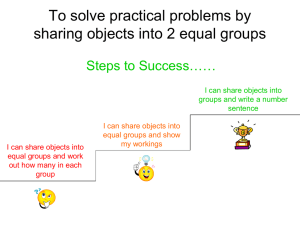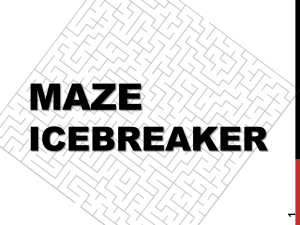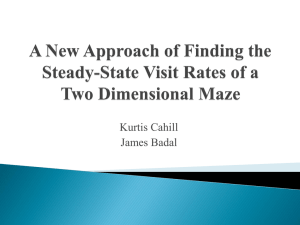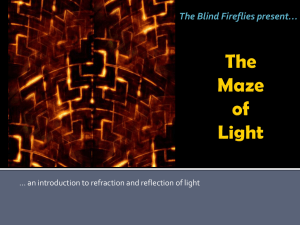Doc
advertisement
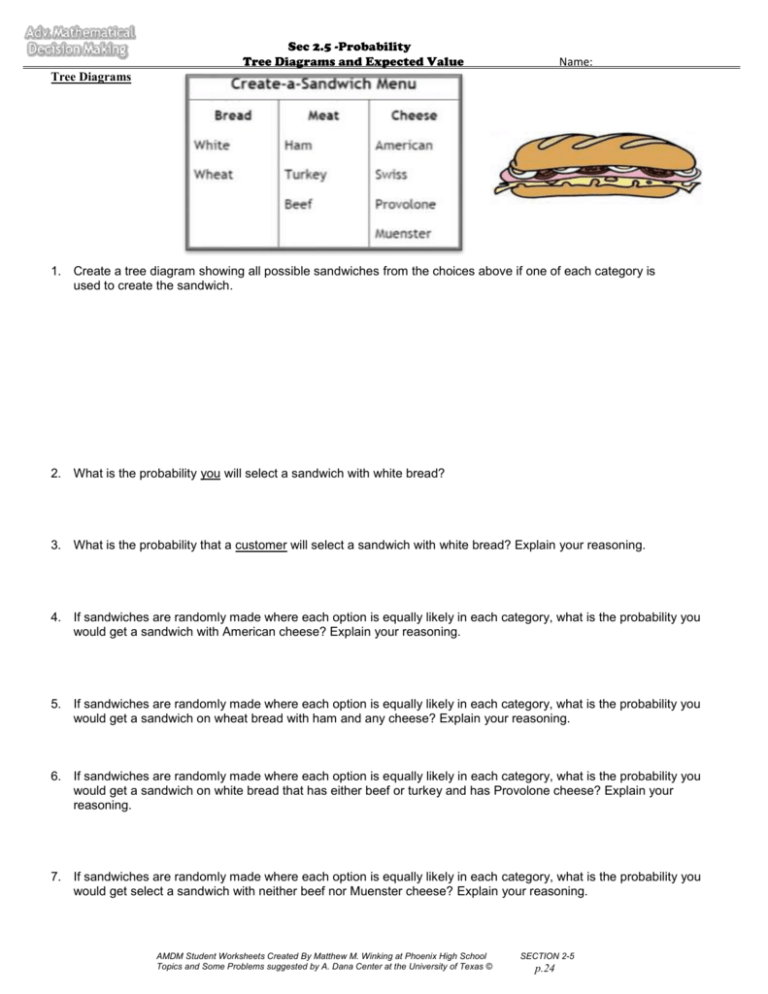
Sec 2.5 -Probability Tree Diagrams and Expected Value Name: Tree Diagrams 1. Create a tree diagram showing all possible sandwiches from the choices above if one of each category is used to create the sandwich. 2. What is the probability you will select a sandwich with white bread? 3. What is the probability that a customer will select a sandwich with white bread? Explain your reasoning. 4. If sandwiches are randomly made where each option is equally likely in each category, what is the probability you would get a sandwich with American cheese? Explain your reasoning. 5. If sandwiches are randomly made where each option is equally likely in each category, what is the probability you would get a sandwich on wheat bread with ham and any cheese? Explain your reasoning. 6. If sandwiches are randomly made where each option is equally likely in each category, what is the probability you would get a sandwich on white bread that has either beef or turkey and has Provolone cheese? Explain your reasoning. 7. If sandwiches are randomly made where each option is equally likely in each category, what is the probability you would get select a sandwich with neither beef nor Muenster cheese? Explain your reasoning. AMDM Student Worksheets Created By Matthew M. Winking at Phoenix High School Topics and Some Problems suggested by A. Dana Center at the University of Texas © SECTION 2-5 p.24 At a car manufacturing plant each option is equally likely to be selected under each category to build a car. Model: Toyonda Corvic Trim Level Exterior Color Interior Color DX Black Black EX Red Gray Si Blue White 8. Create a tree diagram showing all possible versions of the car from the choices above if one of each category is used to create the car. 9. If each option under each category is equally likely to be selected, what is the probability that the first car being made on a given day has a Black Exterior and a Black Interior? A church group in Washington state sells pumpkins every year to raise money for the children of their town. This year’s crop, however, produced very small pumpkins. The group decided to construct a corn maze in a field and charge customers to walk through the maze. Customers can only walk forward. If the customers end up at an exit with pumpkins, they win a pumpkin. The church group asked some students to advise it on various possibilities of a customer getting a pumpkin. Students were shown a simple maze as an example. 10. Make a tree diagram to show the group the possible paths customers might take, entering the maze on the upper, middle, or lower path and proceeding to an exit with or without a pumpkin (at each fork in the maze a person is equally likely to take any path. Finally, find the probability of ending at each gate. AMDM Student Worksheets Created By Matthew M. Winking at Phoenix High School Topics and Some Problems suggested by A. Dana Center at the University of Texas © SECTION 2-5 p.25 11. A farmer created a corn maze. He charged $10 to run through the maze. Some of the trails led to winning a cash prize of $20. a. Make a tree diagram to show the group the possible paths customers might take, entering the maze on the upper, middle, or lower path and proceeding to an exit with or without a pumpkin (at each fork in the maze a person is equally likely to take any path. Finally, find the probability of ending at each gate. b. Determine on average expected cost or gain to each person who runs through the maze. Expected Values are weighted probability or percentages. How a teacher calculates your overall grade is done the same way an expected value. Let’s consider the expected value of a single standard 6-sided roll of a die. EMPERICALLY: Roll a die several times and find the average value of all of the outcomes. Below is a sample of 10 rolls of a die. The more trials the closer the empirical should come to matching the theoretical expected value by the Law of Large Numbers. Based on these trials the average result or approximate expected value would be: E ( A roll of a die) 1 3 3 5 6 5 1 4 2 1 31 3.1 10 10 THEORETICALLY: We would find the probability of each event occurring and multiply it by the number occurring. There is a 16 chance of each number occurring. 1 1 1 1 1 1 E ( A roll of a die) 1 2 3 4 5 6 3.5 6 6 6 6 6 6 AMDM Student Worksheets Created By Matthew M. Winking at Phoenix High School Topics and Some Problems suggested by A. Dana Center at the University of Texas © SECTION 2-5 p.26 12. Find the expected value of rolling a four sided tetrahedral die. Each of the four faces are equally likely to land on and the faces are numbered 1 through 4. 13. Find the expected value of the spinner shown. The spinner is equally likely to land on any of the 8 sectors. 14. In the card game 21, face cards count as 10 points, Aces count as 11 points, and number cards count the same number of points as the number on the card. Find the expected value of drawing the first card out of a shuffled deck of cards. 15. (GAME) A person created a game in which a player pays $2 to play. Then, they roll a standard six sided die. If it lands on a 5 or a 6, they get $5 (i.e. they get their original $2 back plus 3 more dollars). If they roll anything else, they just lose their $2 they paid to play. What is the expected value of each game to the player? 16. (GAME) A person created a game in which a player pays $4 to play. Then, they draw a card from a standard deck of shuffled cards. If they draw a numbered card they get $5 and if they draw an Ace they get $6. If they draw anything else they just lose the $4 they paid to play. What is the expected value of each game to the player? 17. (INSURANCE) An auto insurance agency charges males 16 – 18 year olds a base price of $1100 for insurance in a given year. Their accuracies have determined that there is a 8.5 % a claim will be made against such a policy at and an average claim of $4900. What does the insurance company expect to make on average off of each policy holder? 18. (BIDS) A construction company wants to submit a bid for remodeling a school. The research and planning needed to make the bid cost $4000. If the bid were accepted, the company would make a net profit of $26,000. Would you advise the company to spend the $4000 if the bid has only 20% probability of being accepted? 19. (INSURANCE) In many airports, a person can pay only $1.00 for a $100,000 life insurance policy covering the duration of the flight. In other words, the insurance company pays $100,000 if the insured person dies from a possible flight crash; otherwise the company gains $1.00 (before expenses). Suppose that past records indicate 0.45 deaths per million passengers. How much can the company expect to gain on one policy? On 100,000 policies? AMDM Student Worksheets Created By Matthew M. Winking at Phoenix High School SECTION 2-5 p.27

